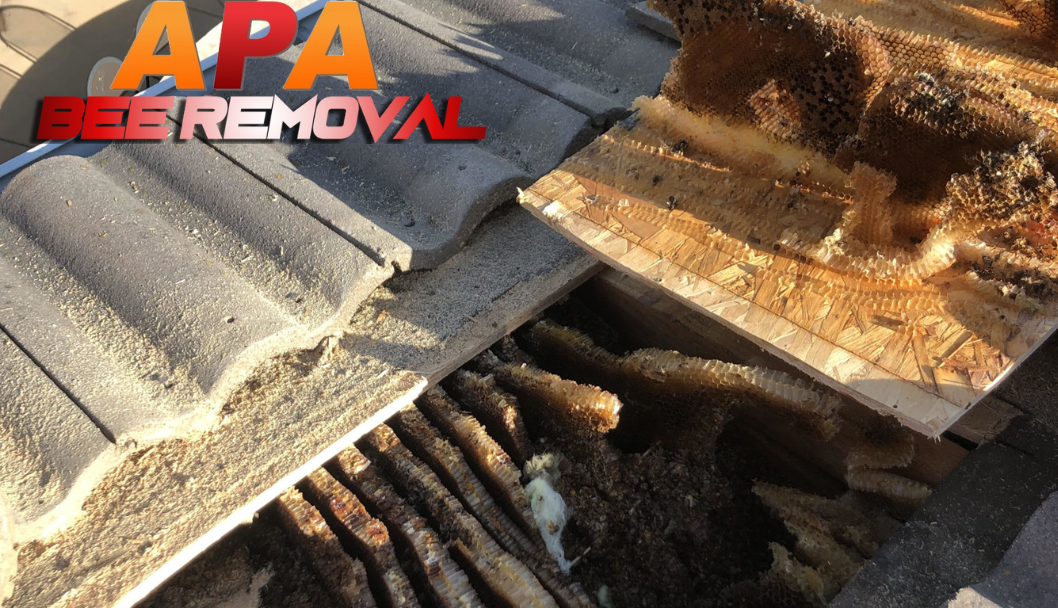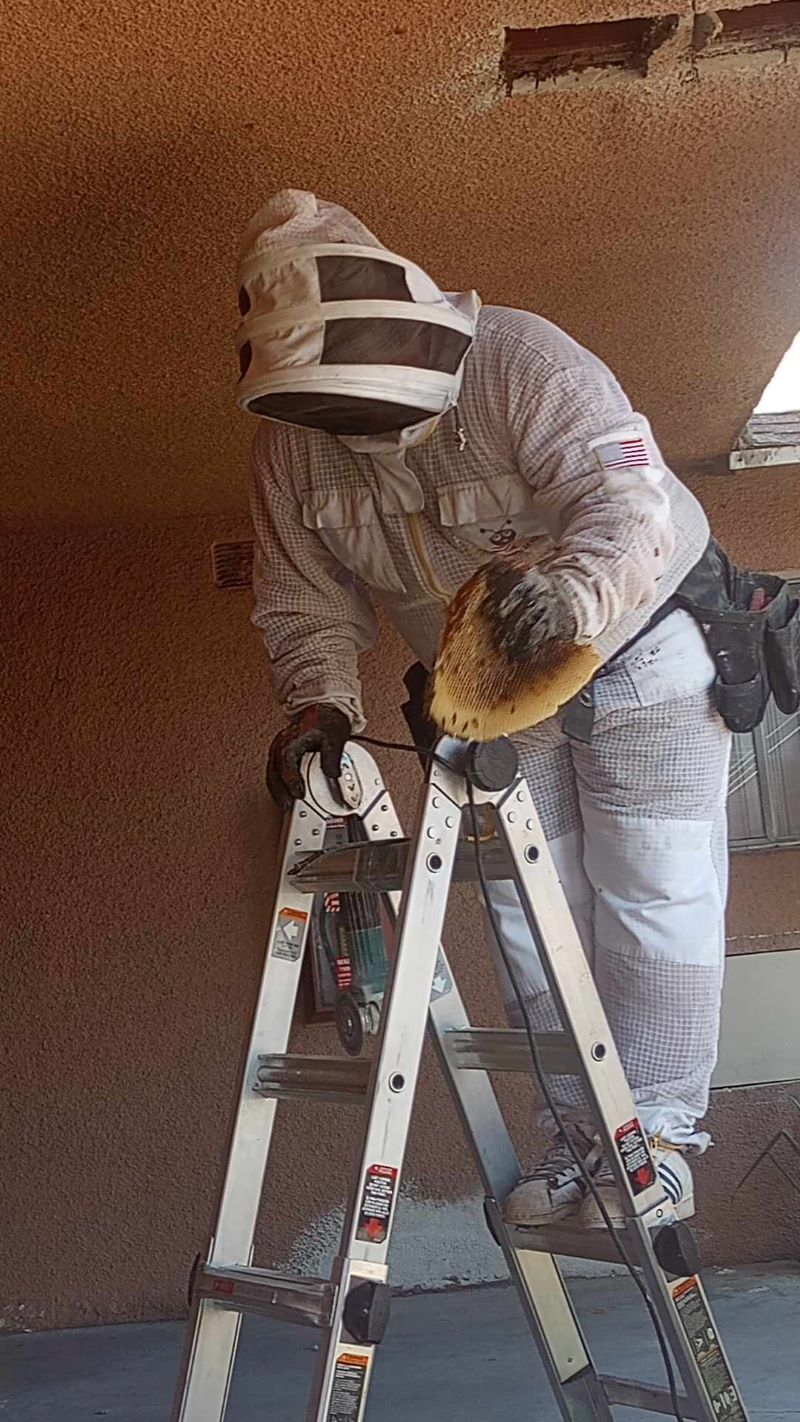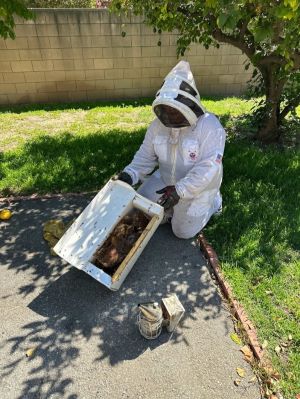ABOUT US
At APA Bee Removal our customers’ satisfaction has always been our number one priority, and it shows in our ratings!
Offering prompt same-day or next-day service on our bee services, you’ll get treatment as soon as you need it!
We utilise bee removal solutions, taking a more environmentally conscious and safe approach to pest management.
Customer satisfaction is our priority. Prepare to witness quality and integrity.
WHY APA BEE REMOVAL ?
APA Bee Removal specializes in eco-friendly beehive removal while offering a satisfaction guarantee. They are the top choice for bee and honey removal. Their focus is on preserving honeybee colonies and providing safe removal services. If you spot bees in or around your property, contact us immediately. Whether it’s a substantial swarm in a tree or just a few bees entering and exiting a hole in your wall, refrain from using chemical sprays directly on the hive or hole. There might be a larger nest inside than anticipated. Instead, reach out to us for safe removal.
WHAT WE DO
 We employ methods to extract hives with minimal structural damage, prioritizing the safety of the nesting bees. Our live honeybee removal process involves careful manual handling or, at times, using a vacuum. The bees are relocated to our local hives to continue their honey production. However, not all hives survive the transplantation process, particularly those previously exposed to sprays. We back every job with our guarantee. We meticulously identify the bees’ entry points and handle your property with the utmost care, aiming to minimize any damage to the roofline, walls, or siding. Our success rate in Los Angeles and Orange County speaks for itself, and we offer the most competitive rates in the area. Contact us for the best possible service and rates.
We employ methods to extract hives with minimal structural damage, prioritizing the safety of the nesting bees. Our live honeybee removal process involves careful manual handling or, at times, using a vacuum. The bees are relocated to our local hives to continue their honey production. However, not all hives survive the transplantation process, particularly those previously exposed to sprays. We back every job with our guarantee. We meticulously identify the bees’ entry points and handle your property with the utmost care, aiming to minimize any damage to the roofline, walls, or siding. Our success rate in Los Angeles and Orange County speaks for itself, and we offer the most competitive rates in the area. Contact us for the best possible service and rates.
What We Offer
- Expert Bee & Honeycomb Removal
- Same Day Service 24/7 Emergency Service
- Free Onsite Inspections By Bee Management Professional
- Honest & Best Prices- Beat Any Quote
- Written guarantees -Licensed and insured
Expert Bee Removal & Repair Services From
- Valve Boxes -Branches- Bushes -Trees-Sheds
- Roofs- Walls- Chimneys- Floors- Siding
- Stucco- Drywall -Attics
- Hard to Reach Building Structures- Crane Work
- Safe All Live Bee Removal and Relocation
- Over 20 Years Experience Structural Removal & Repair
- Best Prices In The Industry


Whether it’s your first encounter with a bee issue or a recurring problem, APA Bee Removal is here to assist you. With over twenty years of experience, our beekeepers have been handling bee removals for residents, businesses, and property managers. California’s conducive temperatures have contributed to a rise in wild bee populations around homes and businesses, prompting the need for professional assistance.
At APA Bee Removal , we conduct numerous bee removals and swarm relocations annually across Los Angeles, and Orange County. Following the removal process, we carefully box the bees for crop pollination purposes. Our expertise extends to removing bees from various locations such as trees, landscaping, roofs, walls, attics, fireplaces, sheds, cars, boats, personal residences, commercial buildings, and more.
Warning: Upon discovering the issue, it’s crucial not to attempt handling it yourself. Honey Bees, Wasps, and Yellowjackets fiercely defend their hives. For your safety, steer clear of the hive and contact a professional equipped with the necessary tools and expertise to remove it safely. Africanized bees, in particular, attack in large numbers, emphasizing the importance of seeking professional assistance immediately.
Some Genuine Words From Our Customers
Trustindex verifies that the original source of the review is Google. The removal expert did a great job today. Answered all of my questions during the removal process. He has 25 years of experience and it showed. I even got some of the honey.Posted onTrustindex verifies that the original source of the review is Google. I found 4 wasp nests at my backdoor and window. I googled beekeeper and found APA BEE REMOVAL. A beekeeper came over 1.5 hous after I gave them a call on weekend. He is quick and efficient. The nests were removed completely and I was told that I have a warranty period of 30 days. I was charged $200 for the service. I appreciate the proficiency and quick responsiveness from APA BEE REMOVAL. I recommend them if you happen to encounter the similar problem for your house.Posted onTrustindex verifies that the original source of the review is Google. Came to my parents home for 4th of July. Notice where bees going in the roof area of the garage. Alex so awsome, friendly and very knowledgeable. came removed the bees and also did the repair. Iam so happy because i hought we would have a hardtime to find someone on a holiday and to respond so quickly. the process was so easy.Posted onTrustindex verifies that the original source of the review is Google. On May 26, 2025, we saw a bee swarm in our orange tree.. called this company and they were out to our house within hours to remove it.. he was so nice and professional.. as of this morning no more bee.. hats off look at the size of the bee swarm Thank you so muchPosted onTrustindex verifies that the original source of the review is Google. He was great. Very professional friendly, and kept us informed of everything he had to do He worked fast and got the job done in about two hours Would definitely use them againPosted onTrustindex verifies that the original source of the review is Google. Called them at one in the morning. They were here within an hour. Quick service friendly will definitely use them again.!Posted onTrustindex verifies that the original source of the review is Google. Had great experience with this company great customer servicePosted onTrustindex verifies that the original source of the review is Google. Gracias a APA BEE. REMOVAL me ayudaron con una colmena que tenía dentro de la pared de mi casa son gente muy buena y profesional los recomiendo muchoPosted onTrustindex verifies that the original source of the review is Google. Alex is amazing, knowledgeable, efficient, and handled bees swiftly. Removed 50 pounds of honey comb and honey.Posted onTrustindex verifies that the original source of the review is Google. Great service at a reasonable price. Alex is super professional and friendly. For our roof top, he had to rent a lift to do the job, The price was reasonable and did a fantastic job putting back the roof. They seem to be really busy, so have a little patient.

The best prices are guaranteed.
We offer reasonable prices for our live bee removal services that are highly competitive in the industry, with no hidden fees. We have a flat rate pricing model that offers you transparent pricing, so there are no unpleasant surprises when it comes time to pay the bill. We have a fast response time and offer emergency call outs in weekends and after hours.
1. The bees are not aggressive and in swarm or early hive formation.
2. The bees are easily accessible and are clustered out in the open and not inside a structure.
3. We are able to place them with a beekeeper in our Best Bee Network.
APA Bee Removal does not recommend self-treatment of a bee infestation. An active colony of honeybees can have 10,000 to 60,000 bees in it. What you see on the outside is only a minuscule fraction of what is under the surface. Spraying an active Colony with any ‘over-the-counter’ substance bought at the local hardware store will give the bees reason to become defensive. Also, this method will only exterminate a small fraction of the problem. When dealing with a Swarm the only self-treatment that APA Bee Removal recommends is to have patience and let nature run its course. A swarm that has landed on something that does not provide them with a suitable nesting place will not usually stay. Swarms may land on tree branches and the like. Spraying a swarm with water or another substance can cause quite a ruckus and the bees will usually settle back down on the same spot. As with a colony, attempting to self-exterminate your visitors with any method can cause defensive behavior. If a swarm on your property makes you uncomfortable and waiting for nature is not a possibility, give us a call!
A swarm is a large group of bees congregating around their queen. Most swarms are in trees or the underside of fascia and eves. A hive, on the other hand, is an established bee colony where you will find the honeycomb and honey that have been carefully constructed. We often find these hives in attics, inside wall spaces, water boxes or trees. APA Bee Removal will remove beehives and honeybee swarms making sure to keep them alive. We will in no way use any chemical pesticide or kill any honeybees! Beehive removal fees are given on an individual basis as there are many elements to consider: is structural access needed and what extent of repairs are necessary.
We perform exceptional bee removal repairs. With over 20 years of construction experience, by the time we are done with any structural repairs from your bee removal, you wouldn’t even know you had a beehive.
Bees need water just like we do. They will gather at swimming pools, ponds, and water coolers in order to find it. Water-collecting bees are docile just as when they are foraging for pollen and nectar. Bees will also communicate to their colony where the best sources of water are so when they find a good spot they are likely to return repeatedly. The only way to rid your property of foraging bees is to take away the water or food source they are coming to. They will become discouraged and go elsewhere. This can be fairly easy with fountains and birdbaths, but not so easily done with an entire pool.
There are always lots of bees in urban areas. Resources here are plentiful and they love our San Gabriel Valley weather. Bees choose locations based on the desirability of a particular nesting site. They love hollow cavity spaces and will check for size, temperature and humidity factors. They want to stay protected from the elements. Any property could be a potential nesting site. Swarms will also stop anywhere that is convenient for them while migrating in search of a new home.
Removing honeybees from a wall requires carpentry experience. A novice beekeeper can cause more damage than good if they are not experts in carpentry.
Read the warranty or guarantee agreement carefully. A good bee removal company will warranty a removal requiring a repair for at least a year.
We do not recommend that. Spraying with water can agitate the bees and they may end up attacking you or others in the surrounding areas instead of leaving. We always try to remove the bees live, and relocate the swarm to a beekeeper or farm.
The cost of bee removal varies depending upon a number of factors. There are three main factors that can effect the cost of a job.
1. The first is the length of time the problem has been going on. If you have a swarm it is less expensive to resolve than if you have a hive. A swarm is a collection of bees that has just landed and is looking to build a hive. A fully established hive can be built in only a couple weeks, so fixing the problem quickly (before the swarm has built a hive) is much less expensive than if a hive has already been established.
2. The second factor that influences the price of a job is where the bees or hive is located. Is it in a tree at eye level that is easy to get to? Or is it 25 feet up in a palm tree? Does it require a ladder? Is it on a hillside or up a steep slope? Do you need to crawl under a structure to get to it? Do you need a boom lift or heavy equipment to reach it? All of these factors dictate the difficulty and price of the job.
3. The third main factor is what materials and tools will be needed to remove the hive? Is the hive in a 3nd story wood shingle roof or a single story Spanish tile roof? Are the bees inside an irrigation box in the ground where the lid can be lifted easily? Or are they inside a concrete wall that needs to be demolished in order to get to the hive? Are the bees in a stucco wall, a wood wall, or a type of wall that has special masonry? All of these examples can effect the cost of the hive removal.
In the case of a Swarm, usually YES. A swarm of bees may stop to rest on just about anything during the migratory process and leave between 1 and 72 hours later. In Orange County, the swarming season occurs mostly during Spring and Fall, but it can occur at other times of the year as well. Established Colonies will NOT leave once they have set up housekeeping except in extenuating circumstances. Bees may choose various hollow cavities to set up colonies such as your roof, eaves, wall voids, water meter boxes, even a BBQ grill or a birdhouse. It only takes bees about 72 hours to start producing honey and combs once they move in.
As soon as you spray bees with chemical pesticides it kills the honeybees but the honey and honey comb are left behind for rodents and pests to feed on and contaminate the area with their droppings. Another reason is that more bees can often occupy the beehive and you have another live beehive on your hands. That’s why it’s critical that the entire beehive and honeycomb are removed from your property.
Unfortunately it can. Bees are very resourceful and can find the trickiest places to build their hives. If they are in your wall space or the crawl space in your house, we will need to gain access by cutting into the structure to effectively remove all remnants of the hive.
No absolutely not. APA Bee Removal is licensed by the State of California to perform our services. Government agencies recommend calling a pest control professional when encountering wild feral bees due to the Africanization in this area.
If a beehive is left behind, the smell of it will attract bees back to the area for years to come. If a typical size beehive is abandoned and is located in an attic or wall, once the bees have departed, the honey will completely melt out of the comb and will destroy drywall, stucco, siding, paint, etc. The abandoned beehive will then attract other pests such as ants and rodents.
You can’t! It requires DNA testing and elaborate measurement tests in order to distinguish the two. The Africanized bee has hybridized with the more friendly European bees that beekeepers brought here first. These hybrids exhibit characteristics of both, and the behavior of a hive can drastically change without warning. Their behavior is NOT an accurate tool to determine whether they are Africanized! You should always just give all bees you encounter the respect you’d give any wild creature.
An experienced beekeeper will identify the location of the bees and how remove the honeybees safely, extract the hive, clean the affected area, apply pesticide to deter honeybees from returning to the empty hive, fill the open area with insulation and replace the wall with the original material whenever possible.
Structural removals need to be estimated and a written approval needs to be received from the owner or property management company before work can begin.
It depends! If they just landed there is a chance they may leave. Although its impossible to predict what bees will do, the general rule of thumb is the longer they stay there, the less likely they will leave. Its common for a swarm to leave after an hour of landing on a tree but less likely when they have been there for more than a day. Once they have built a hive they are usually there to stay.
